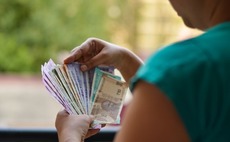
Asia credit: Shift in the cycle

Private debt investors in Asia are mindful of mounting global risks, but they also see opportunities emerging within the region across the capital structure
From globalisation to slowbalisation to de-globalisation, Asia-focused private credit investors have tracked the adoption of nationalistic economic policies, the decline in global trade volumes, and the fracturing of supply chains with one eye on their risk exposure and the other on opportunities that may emerge amid the chaos.
"The supply chain issue, the regionalisation of economic interconnection, is an important factor in portfolio construction. It is changing and you need to be in front of that, not behind. We must think differently about globalisation, and what risks we should be mitigating on the macro that we used to take for granted," Rob Petty, co-CEO and co-CIO of Fiera Capital, told the AVCJ Private Credit Forum.
In the past quarter, the landscape has shifted once again, with the Russia-Ukraine conflict, the rise of omicron, and the US Federal Reserve suggesting that a more aggressive series of interest rate hikes are required to curb inflation. Yields on two-year Treasury bonds have swept past 2.5%, suggesting investors expect interest rates will be near that level by year-end, up from the current 0.25%.
Return expectations in areas like direct lending have moderated from the mid-teens to around 10%. But Petty observed that, in current conditions, this is attractive for a senior secured instrument fully hedged in US dollars or euros – potentially outperforming the US and Europe, while offering stability.
"At the end of a 30-year bull market in fixed income, where do you want to be? Institutions and private wealth are moving out of conventional fixed-income given interest rates, volatility, and uncertainty. Private credit is a compelling place to be," he said. "And then, separately, there are real opportunities in special situations."
Identifying entry points
That stability of direct lending and opportunity in special situations are uttered in the same breath show how finely the market is poised. For some investors, especially those that operate across the credit spectrum, the vigour with which central banks pursue tightening policies is the tipping point. Ultimately, that will dictate how quickly the cycle moves through special situations toward distress.
There is already evidence of a rebalancing, according to Anil Gorthy, a senior portfolio manager at Avenue Capital Group. In direct lending, yields have become so compressed in recent years that senior debt in Australia was priced at 6%, borrowers in India were asking for 12-15% in rupee terms, and opportunities in China evaporated as the equity markets took business away from debt players.
Now, though, pricing in Australia has crept up to 8-9%, while in other markets there is increasingly a willingness to part with a slice of equity – giving the lender some upside on top of the debt piece – to make deals happen. Distress-style fire sales have yet to materialise, but borrowers will pay more to meet their immediate liquidity needs as balance sheets come under pressure.
"If interest rates stay 1-2% higher for another two quarters, those conversations will become more real and consistent. In 6-12 months, spreads could be wider across the board, and that is the early stages of the distress cycle. Today, it is more special situations and lending," Gorky told the forum.
At the same time, macroeconomic forces coexist with structural trends and local nuances. The direct lending story in Asia is shaped by banks withdrawing from the space due to regulatory pressures, leaving a rump of small and medium-sized enterprises (SMEs) that have always struggled to obtain funding from traditional sources even more underserved.
SMEs in Asia Pacific account for more than nine out of 10 companies and two-thirds of employment, yet they receive 18% of bank lending, according to the Asia Pacific Economic Cooperation (APEC) Policy Support Unit. A 2017 study led by the International Finance Corporation (IFC) found that unmet demand for SME financing amounted to USD 4.5trn globally, of which USD 2trn was in Asia.
Andrew Tan, head of Asia Pacific private debt at Muzinich, noted that sometimes banks must put aside twice as much regulatory capital as they lend out to SMEs. The resultant pullback has created opportunities for private debt providers targeting companies with USD 5m to USD 50m in EBITDA. Typically, they need additional capital for M&A and capital expenditure to get them to the next level.
Tan added that Asia also suffers from the lack of a collateralised loan obligation (CLO) market. Banks have no standardised market to sell non-core senior secured loans, and if there are few willing buyers among their peers, credit managers can pick debt at attractive valuations.
Other relevant SME trends in Asia range from the provision of essential infrastructure to digitalisation to cross-border expansion. They serve as supporting evidence to the argument that the prospects for direct lending, and for private credit more generally, hinge as much on individual markets, business models, and companies as on global macro themes.
"Interest rate hikes do sound a bit of a warning note in terms of impact on credit, liquidity, and the ability of companies to weather COVID as their EBITDA falls and there aren't huge amounts of funding to support them," Sabita Prakash, a managing director at ADM Capital, said at the forum.
"But the spreads we charge are more dependent on credit profiles than duration and interest rates. If rate hikes come together with improvement in the overall scenario for growth, you could argue that companies' overall growth and credit is improving and therefore spreads should remain constant."
Against the grain
China is perhaps the prevailing standout example of a market that offers succour for contrarians who have sufficient comfort and local resources to look past immediate headwinds.
Risk factors bound up in geopolitical tensions, the pandemic, and the fallout from efforts to de-lever the real estate sector have prompted many investors to review their exposure. Yet Petty observed that, while "everyone loves to be concerned about China," Fiera believes the country remains a significant part of the global economy and can deliver double-digit returns.
Indeed, Ben Fanger, managing partner of China-focused Shorevest Partners, which buys portfolios of non-performing loans (NPLs) and targets special situations investments, claims the opportunity set is as attractive as it has ever been.
"In 2017, China made a conscious decision to get banks to recognise more NPLs. In 2018-2019, pricing wasn't great because many foreign groups were trying to buy their first NPLs. Starting in January 2020, deal flow has been the best I've seen since 2006," he said.
"What's driving that? In 2020 and 2021, Chinese banks recognised and disposed of CNY 3trn (USD 457bn) of NPLs each year. In 2017, it was CNY 1.5trn. More apples for sale means cheaper apples."
This view was endorsed by Alex Wu, a managing director and head of special situations at CDH Investments. He also pointed to a surge in companies going through bankruptcy proceedings, including large-scale enterprises such as beleaguered property developer China Evergrande Group, which has onshore and offshore liabilities amounting to more than USD 300bn.
The circumstances that contributed to Evergrande's predicament – notably the "three red lines" that prevent banks from lending to developers when liabilities exceed 70% of assets, net gearing is above 100%, and cash exceeds short-term borrowings – are creating special situations opportunities too.
With banks subject to tighter lending guidelines, challenges accessing the bond market, and the shadow banking system a fraction of its former self, Chinese companies have no choice but to approach institutional private credit managers. Shorevest claims to generate returns of 20% or more from senior loans backed by hard assets.
Around the region
Other markets in Asia are unable to match the scale of China's NPL opportunity, but openings are emerging across the capital structure. Distress deals in Australia and New Zealand have been in short supply following government stimulus efforts and a liquidity boom. However, turnaround specialist Allegro Funds is encouraged by recent developments – some of them only a few months old.
"In the last couple of months, some lenders have lost patience with COVID-impacted businesses. We had a good run at an aviation business last year where international lenders wanted to trade their debt. Now, we are looking at an after-school care business where North Asian lenders holding syndicated loans are reluctant to wait longer," said Johan Krynauw, a managing director at Allegro.
"We can buy the debt at a discount and do loan-to-own. These are often good businesses with bad balance sheets, but the lenders cannot, or do not want, to hold equity."
Even more recently, the firm has seen an influx in failed sale processes. Most assets sold towards the end of 2021 were able to command premium valuations, but amid the uncertainty around interest rates hikes and geopolitical instability, enthusiasm has waned. Allegro has received inquiries from companies looking at alternative financing solutions and partners who can help drive growth.
Much the same appears to be happening in the growth capital space in Asia among start-ups that granted investors put options, triggered by failing to deliver an IPO or trade sale exit within a given period, as part of earlier funding rounds. The put options are now being enforced as investors look to pull money out of the system and start-ups are looking to private debt to fill the gap.
"Some of these guys have realised that going for growth at any cost, without thinking about the bottom line, is probably not the right way in the current environment," said Tan of Muzinich. "They are turning to us for private debt capital. Six months ago, this wouldn't have happened because everyone thought more hot money would come into the space."
Regardless of geography, investors are testing different scenarios arising from supply chain disruption and the impact on the ability of borrowers to manage costs as well as to secure inputs and deliver finished products on time and to specification.
Helicap, which connects accredited investors with companies looking for financing solutions in Southeast Asia and manages open-ended funds that invest in non-bank lenders and financial technology platforms, has seen more capital flow into the space as credit providers devise new strategies targeting different levels in the capital structure.
The pandemic has accelerated this trend as performing non-bank lenders strengthened their balance sheets with new equity funding. Nevertheless, Quentin Vanoekel, co-founder and CIO of Helicap, shared his concerns with the forum about rising food prices and energy shortages translating into inflationary pressures that hit the purchasing power of the micro-entrepreneur consumers that he funds.
"Would their ability to pay be impacted? Absolutely. So, we must stay ahead of the curve. That's why if you really want to access this market you need appropriate tools to monitor risk. We look at data from loan management systems we are plugged into and based credit decisions on that," he said.
"Should fund managers start thinking about floating rates and longer tenor loans? Absolutely. And they must think in US dollar terms, to mitigate underlying currency risk. Returns of 8% to mid-teens are possible, but you need to be sophisticated in these conditions."
Steady maturation
A key consideration from a fundraising perspective is whether LPs recognise not only the private credit investment opportunity in Asia but also the ability of managers and the robustness of the broader ecosystem to capitalise on it.
The consensus view is that institutional investors are open to increasing their private credit exposure given expected lower returns in the public markets. Yet the maturation of Asia in the past 20 years – seen in the emergence of bankruptcy regimes in China and India, the strength of senior secured debt in Australia, and the deepening of hard asset-based lending in Japan – is often underestimated.
"While we have room to grow and mature, there is now a diversity of strategies and the ability to do a dedicated direct lending strategy, a dedicated open-ended strategy, perhaps a dedicated geographic strategy," said Fiera's Petty. "The diversity and depth of the market are greater than is commonly acknowledged."
Participation by large-cap global managers remains somewhat patchy in the region – a consequence of large minimum ticket sizes of USD 100m to USD 200m and certain groups having tried and failed before. This remains an obstacle to Asian private debt becoming truly mainstream, but Petty claimed that LPs with sophisticated credit programs in the US and Europe are now looking at Asia. Should the region emerge as a beacon of stability, demand would inevitably increase.
"I was in the Middle East for fundraising, and one of the investors re-upping in our fund said: ‘China credit has never looked better,'" Shorevest's Fanger added. "Why is that? In Europe, there is geopolitical uncertainty. In the US, no one knows what happens when trillions of dollars of stimulus are removed. When you look at Asia, it's reasonably clear, country by country, where we are at."
Latest News
Asian GPs slow implementation of ESG policies - survey
Asia-based private equity firms are assigning more dedicated resources to environment, social, and governance (ESG) programmes, but policy changes have slowed in the past 12 months, in part due to concerns raised internally and by LPs, according to a...
Singapore fintech start-up LXA gets $10m seed round
New Enterprise Associates (NEA) has led a USD 10m seed round for Singapore’s LXA, a financial technology start-up launched by a former Asia senior executive at The Blackstone Group.
India's InCred announces $60m round, claims unicorn status
Indian non-bank lender InCred Financial Services said it has received INR 5bn (USD 60m) at a valuation of at least USD 1bn from unnamed investors including “a global private equity fund.”
Insight leads $50m round for Australia's Roller
Insight Partners has led a USD 50m round for Australia’s Roller, a venue management software provider specializing in family fun parks.








